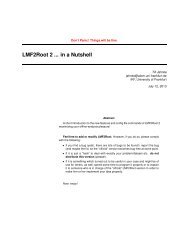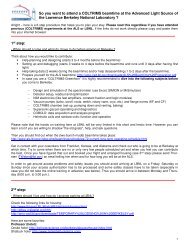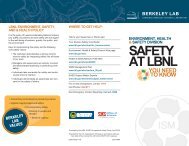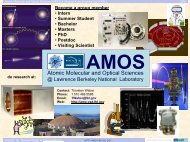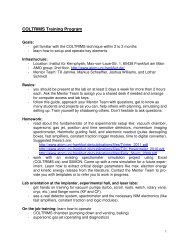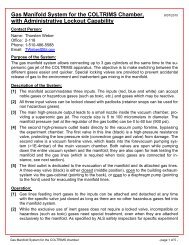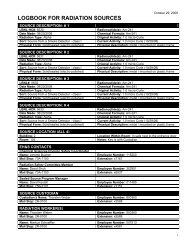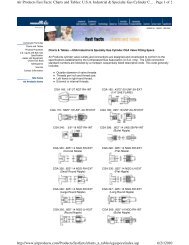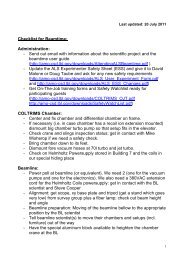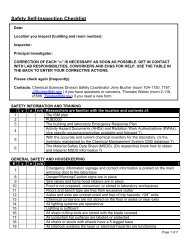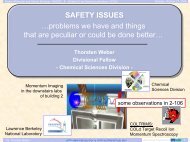Cylinder Size and Colour Chart Medical Applications
Cylinder Size and Colour Chart Medical Applications
Cylinder Size and Colour Chart Medical Applications
You also want an ePaper? Increase the reach of your titles
YUMPU automatically turns print PDFs into web optimized ePapers that Google loves.
<strong>Medical</strong> Gases <strong>and</strong> Equipment Catalog<br />
<strong>Cylinder</strong> <strong>Size</strong> <strong>and</strong> <strong>Colour</strong> <strong>Chart</strong> <strong>Medical</strong> <strong>Applications</strong><br />
(Purple body)<br />
(Dark orange body)<br />
(Blue)<br />
(Cranberry Red)<br />
(Black <strong>and</strong> White<br />
shoulder)<br />
<strong>Medical</strong> Air, U.S.P.<br />
Grade<br />
CGA 346 <strong>and</strong> CGA body)<br />
950 (E <strong>and</strong> D sizes<br />
only) (Gray<br />
(Brown shoulder)<br />
Helium (He), U.S.P.<br />
Grade<br />
CGA 580 <strong>and</strong> CGA<br />
930 (E <strong>and</strong> D sizes<br />
only)<br />
Nitrous Oxide<br />
(N 2 O), U.S.P. Grade<br />
CGA 326 <strong>and</strong> CGA<br />
910 (E <strong>and</strong> D sizes<br />
only)<br />
Specialty Gas<br />
Mixtures<br />
(Pink Shoulder)<br />
Various CGAs<br />
(Black body)<br />
(Green body)<br />
Caution:<br />
(Grey shoulder)<br />
Carbon Dioxide<br />
(CO 2 ) U.S.P. Grade<br />
CGA 320 <strong>and</strong> CGA<br />
940 (E <strong>and</strong> D sizes<br />
only)<br />
Nitrogen (N 2 ),<br />
NF Grade<br />
CGA 580 <strong>and</strong> CGA<br />
960 (E <strong>and</strong> D sizes<br />
only)<br />
(White shoulder)<br />
Oxygen (O 2 ),<br />
U.S.P. Grade<br />
CGA 540 <strong>and</strong> CGA<br />
870 (E <strong>and</strong> D sizes<br />
only)<br />
Do not use cylinder colour<br />
to identify gases.<br />
Always read labels to<br />
identify contents. CGA<br />
connection may be used<br />
as a secondary check of<br />
contents.<br />
High Pressure <strong>Cylinder</strong>s<br />
Cryogenic Containers<br />
Product Gas (Use) Liquid<br />
Nitrogen – Cryogenic Liquid CGA 580 CGA 295<br />
Oxygen – Cryogenic Liquid CGA 540 CGA 440<br />
Carbon Dioxide – Refrigerated Liquid CGA 320 CGA 622<br />
Nitrous Dioxide – Refrigerated Liquid CGA 326 CGA 326<br />
Praxair <strong>and</strong> the Flowing Airstream design are trademarks or registered trademarks of Praxair Technology, Inc. in the United States <strong>and</strong>/or other countries. Other trademarks<br />
used herein are trademarks or registered trademarks of their respective owners. The information contained herein is offered for use by technically qualified personnel at their<br />
discretion <strong>and</strong> risk without warranty of any kind. © 2010, Praxair Technology, Inc. All rights reserved. Praxair Healthcare Services, Inc., Danbury, CT 06810-5113<br />
60 in.<br />
50 in.<br />
40 in.<br />
30 in.<br />
20 in.<br />
10 in.<br />
0 in.<br />
<strong>Cylinder</strong> <strong>Size</strong> T K S M/DEY O R G F E/ME MEXRS D/MD MDXRS<br />
70 in.<br />
60 in.<br />
50 in.<br />
40 in.<br />
30 in.<br />
20 in.<br />
10 in.<br />
0 in.<br />
Container<br />
<strong>Size</strong><br />
<strong>Size</strong><br />
Code<br />
36 in.<br />
30 in.<br />
24 in.<br />
18 in.<br />
12 in.<br />
6 in.<br />
0 in.<br />
Dewar<br />
<strong>Size</strong><br />
HP-180<br />
(GP-55)<br />
471<br />
271/274<br />
HP-160<br />
(GP-55)<br />
471<br />
271/274<br />
LD Series Dewars<br />
LS-160<br />
471<br />
271<br />
CD-170 LS-180 XL-230/240<br />
471<br />
271<br />
471<br />
271<br />
472<br />
272<br />
LD4 LD5 LD10 LD25 Classic 25 LD35 LD50
<strong>Medical</strong> Gases <strong>and</strong> Equipment Catalog<br />
General Safety Information<br />
Moving <strong>Cylinder</strong>s <strong>and</strong> Containers<br />
<strong>Cylinder</strong>s <strong>and</strong> containers must always be moved carefully. Mish<strong>and</strong>ling<br />
that results in a damaged valve or ruptured cylinder can expose personnel<br />
to the hazards associated with these gases. In addition, most gas<br />
cylinders are heavy <strong>and</strong> bulky. A cylinder striking someone or pinching<br />
a finger, toe, or other extremity is a common cause of injury. For these<br />
reasons, all cylinder h<strong>and</strong>lers must always wear certain minimum<br />
personal protective equipment prescribed by OSHA.<br />
•<br />
•<br />
•<br />
Gloves to protect h<strong>and</strong>s against common pinching injuries.<br />
Safety glasses to protect eyes against injuries associated with pressure<br />
release<br />
Safety shoes with metatarsal supports to protect against foot injuries<br />
from falling cylinders.<br />
Before moving the cylinder to the storage area or point of use or<br />
before returning the cylinder to the supplier, ensure the following:<br />
• The outlet valve is fully closed.<br />
• The outlet valve dust plug or pressure cap is on tight for cylinders<br />
equipped with these protection devices (where supplied).<br />
• The valve protection cap is properly secured in place on cylinders<br />
with neck threads (where supplied). Note: Valve caps must always<br />
be in place while moving or transporting cylinders or when they are<br />
in storage.<br />
While moving full or empty cylinders:<br />
•<br />
•<br />
•<br />
Always use carts or h<strong>and</strong> trucks designed for this purpose.<br />
Never drop cylinders or allow them to strike each other violently.<br />
Never lift cylinders by the cap or with a lifting magnet.<br />
After moving a cylinder to its point of use, secure the cylinder in place.<br />
Use cylinder st<strong>and</strong>s, clamps, or other securing devices recommended<br />
by your supplier.<br />
Storing <strong>Cylinder</strong>s <strong>and</strong> Containers<br />
Storage of compressed gas cylinders <strong>and</strong> cryogenic liquid cylinders is<br />
governed by codes of the National Fire Protection Association (NFPA).<br />
Local codes may also apply. Know <strong>and</strong> obey codes governing storage<br />
at your location.<br />
Safe Practices<br />
In general, store cylinders so they can’t be easily toppled over.<br />
Remember, danger exists not only from accidental release of gas by<br />
cylinders damaged in a fall but also from their striking someone <strong>and</strong><br />
causing injury. Store cylinders upright in compact groups, interlocking<br />
them so that each cylinder physically contacts those around it. Do not<br />
st<strong>and</strong> cylinders loosely or in a haphazard manner. A single cylinder that<br />
topples over can create a domino effect causing other cylinders to fall.<br />
Single cylinders should be secured in place or on a cylinder cart so they<br />
can’t be easily knocked over. Keep stored cylinders out of high traffic<br />
areas. Do not store them near the edges of platforms. Avoid storage<br />
in areas where there are activities that could damage or contaminate<br />
the cylinders. Electric arc welding can destroy the integrity of cylinder<br />
metal if a welder carelessly strikes an arc on a cylinder. Overhead hoists<br />
can drip oil or grease on cylinders, contaminating them. Never store<br />
cylinders with flammable materials.<br />
Opening <strong>and</strong> Closing Valves<br />
Observing a few simple rules when opening <strong>and</strong> closing valves can<br />
prevent damage to valves <strong>and</strong> equipment <strong>and</strong> add years of useful<br />
service life to the valves. Praxair supplies a new gasket/washer with<br />
each cylinder equipped with a post-style valve to ensure a gas-tight<br />
connection with the gas regulating device. The gasket provided is<br />
designed for single-use <strong>and</strong> must be discarded every time a regulator<br />
or cylinder is changed. When changing the regulator or cylinder in a<br />
post-style valve, remove the dust cover <strong>and</strong> never use more than one<br />
gasket to provide the gas-tight seal. Always refer to the manufacturer’s<br />
instructions for attaching the regulator to the cylinder. The proper way<br />
to open any cylinder valve is to first “crack” the valve (open the cylinder<br />
valve momentarily <strong>and</strong> then close it), then open it slowly by turning the<br />
h<strong>and</strong>le or stem counterclockwise. This allows equipment to gradually<br />
adjust to full pressure. Stop turning as soon as there is any resistance.<br />
Turning the valve h<strong>and</strong>le or stem too far in the open position can jam the<br />
stem causing damage <strong>and</strong> leaks <strong>and</strong> preventing later closure. Likewise,<br />
overtightening when closing a valve can damage or permanently distort<br />
the seat <strong>and</strong> result in leakage.<br />
Receiving <strong>Cylinder</strong>s – External Inspection<br />
Personnel responsible for receiving cylinders should perform an external<br />
inspection on all packages before moving them to the point of use<br />
or to the storage area. Basic guidelines for performing this inspection<br />
are as follows:<br />
Read the cylinder labels to be sure that the gas is what you ordered<br />
<strong>and</strong> that you underst<strong>and</strong> the hazards associated with the product.<br />
Remember, the label is the only means of identifying the product in<br />
the cylinder. Never identify the product by the color of the cylinder. A<br />
secondary check of contents may be made by using the CGA connection<br />
on the valve.<br />
Check the TC/DOT cylinder markings to be sure you underst<strong>and</strong> the<br />
pressures contained in the cylinders.<br />
Thoroughly inspect the cylinders for any obvious damage. The cylinder<br />
surface should be clean <strong>and</strong> free from defects such as cuts, gouges,<br />
burns <strong>and</strong> obvious dents. Such damage could weaken the cylinder<br />
metal, creating a danger of failure, or it could make the cylinder unstable<br />
<strong>and</strong> more likely to tip over. Make sure the cylinder st<strong>and</strong>s steady<br />
on its base <strong>and</strong> does not wobble.<br />
<strong>Cylinder</strong>s with neck threads should have a cap in place over the valve.<br />
Remove the cap by h<strong>and</strong>. Never use a screwdriver, crowbar, or other<br />
leverage device to remove the cap. You could accidentally open the<br />
valve or damage it.<br />
Check the cylinder valve to be sure it is not bent or damaged. A damaged<br />
valve could leak or fail, or it might not make a tight connection<br />
when the cylinder is placed into use. Make sure the valve is free from<br />
dirt <strong>and</strong> oil, which could contaminate the gas. Dirt particles propelled in<br />
a high velo-city gas stream could cause a spark, igniting a flammable<br />
gas. Oil <strong>and</strong> grease can react with oxygen <strong>and</strong> other oxidizers, causing<br />
an explosion.<br />
If any cylinder is received with missing or unreadable labels <strong>and</strong><br />
markings; visible damage; an unstable base; a missing cap; or a bent,<br />
damaged, or dirty valve, do not use the cylinder. Contact your supplier<br />
<strong>and</strong> ask for instructions.<br />
Testing for Leaks<br />
After completing the external inspection, proceed as follows:<br />
• Test the cylinder valve for leaks using the leak test method approved<br />
by your employer. If you detect leakage, follow the employer’s procedures<br />
for h<strong>and</strong>ling leaking cylinders. Note: It is normal for cryogenic<br />
liquid cylinders to vent through their relief valves to relieve excess<br />
pressure build up due to heat leak. This venting is not a leak.<br />
•<br />
If no leak is detected, secure the cylinder valve cap in place before<br />
moving the cylinder to the point of use or to the storage area.<br />
Praxair <strong>and</strong> the Flowing Airstream design are trademarks or registered trademarks of Praxair Technology, Inc. in the United States <strong>and</strong>/or other countries. Other trademarks<br />
used herein are trademarks or registered trademarks of their respective owners. The information contained herein is offered for use by technically qualified personnel at their<br />
discretion <strong>and</strong> risk without warranty of any kind. © 2010, Praxair Technology, Inc. All rights reserved. Praxair Healthcare Services, Inc., Danbury, CT 06810-5113



